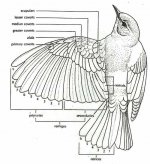Abbygirl said:
HI, Yes I do have a field guide, and that's why i asked the question cause the field guide pictures didn't make sence to me. So the primary and seconardy feather are on the same wing is that correct? and so If I read both of your illustrations right the Primary is on the Outer part of the wing and the Secondary is on the inner part of the wing? unless I just understood that completly wrong? let me know. THanks.
Joyce
ps- i do understand some pictures better with good explanations. thanks a bunch!
pps- I have a Willamette Valley ORegon guide, but it doesn't have a picture in it. But the one we got from the library does. and the picture of the primary and secondary feather's doesn't make sence to me. thanks for helping me out.
You have it more or less correct. Here is a real bird to compare to Adams second diagram.
The primaries, as you say, are the 9 or 10 feathers closest to the end of the wing. They are the longest flight feathers and tend to be a little more asymetrical than the secondaries. When the wing is folded these are the ones that stick out along side the tail.
Secondaries are the next 10 feathers along the trailing edge of the wing, and tend to be fairly uniform in shape and size. They usually pile up on one another when the wing is folded, as you can see in the photo.
Tertials are the 3 or 4 remaining feathers along the trailing edge of the wing that are closest to the body. They are usually quite visible in a folded wing because they are stacked on top of the secondaries.
Greater wing coverts are the next row of feathers in front of the secondaries, and they cover the base of the secondaries. If the bird has wing bars it is the tips of these feathers that produce it. The bird in the photo has a whitish wing bar here.
Median wing coverts are the next row of feathers, which can also show a wing bar, as can be seen in the photo.
Lesser wing coverts are frequently hard to discern, as in this bird.
Scapulars are a row of feathers growing from the shoulder/back area (hence the name) that tend to cover the boundary between the body and the wing.
Compare the diagram and the photo and try to visualize how the feathers fit when the wing folds up. Then go to the gallery and find the same feathers in other photos.
(Sorry this bird's upside down, but it's the only one I have with clean details)
Hope that helps.
Scott





